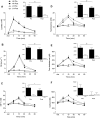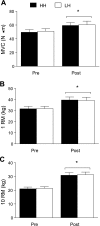Elevations in ostensibly anabolic hormones with resistance exercise enhance neither training-induced muscle hypertrophy nor strength of the elbow flexors - PubMed (original) (raw)
Elevations in ostensibly anabolic hormones with resistance exercise enhance neither training-induced muscle hypertrophy nor strength of the elbow flexors
Daniel W D West et al. J Appl Physiol (1985). 2010 Jan.
Abstract
The aim of our study was to determine whether resistance exercise-induced elevations in endogenous hormones enhance muscle strength and hypertrophy with training. Twelve healthy young men (21.8 +/- 1.2 yr, body mass index = 23.1 +/- 0.6 kg/m(2)) trained their elbow flexors independently for 15 wk on separate days and under different hormonal milieu. In one training condition, participants performed isolated arm curl exercise designed to maintain basal hormone concentrations (low hormone, LH); in the other training condition, participants performed identical arm exercise to the LH condition followed immediately by a high volume of leg resistance exercise to elicit a large increase in endogenous hormones (high hormone, HH). There was no elevation in serum growth hormone (GH), insulin-like growth factor (IGF-1), or testosterone after the LH protocol but significant (P < 0.001) elevations in these hormones immediately and 15 and 30 min after the HH protocol. The hormone responses elicited by each respective exercise protocol late in the training period were similar to the response elicited early in the training period, indicating that a divergent postexercise hormone response was maintained over the training period. Muscle cross-sectional area (CSA) increased by 12% in LH and 10% in HH (P < 0.001) with no difference between conditions (condition x training interaction, P = 0.25). Similarly, type I (P < 0.01) and type II (P < 0.001) muscle fiber CSA increased with training with no effect of hormone elevation in the HH condition. Strength increased in both arms, but the increase was not different between the LH and HH conditions. We conclude that exposure of loaded muscle to acute exercise-induced elevations in endogenous anabolic hormones enhances neither muscle hypertrophy nor strength with resistance training in young men.
Figures
Fig. 1.
Whole blood lactate (A) and serum growth hormone (GH; B), IGF-1 (C), total testosterone (D), free testosterone (E) and cortisol (F) concentrations at rest and after low hormone (LH) and high hormone (HH) exercise protocols. Insets: net area under the curve (AUC; rest = 0); closed bars, HH; open bars, LH. Significantly greater than LH for corresponding time points and for AUC, *P < 0.01, †P < 0.001. Values are means ± SE.
Fig. 2.
Maximal voluntary contraction (MVC; A), one-repetition maximum (1 RM; B), and 10-repetition maximum (10 RM; C) before and after training in LH and HH. *Main effect of training, P < 0.001; there were no interactions (training × condition) for any strength measure (P = 0.65, 0.43, 0.63 for MVC, 1 RM and 10 RM, respectively). Values are means ± SE.
Fig. 3.
T_ype I (A) and II fiber (B) cross-sectional area (CSA) of the biceps brachii before (Pre) and after (Post) training in LH and HH; main effect of training, *P < 0.01, †_P < 0.001. Elbow flexor CSA before and after training (C) in LH and HH; main effect of training, †P < 0.001. Elbow flexor CSA as a function of distance from the elbow joint line before and after training (D) in LH and HH; main effect of training, †P < 0.001. There were no interactions (training × condition) for either fiber or whole muscle CSA (type I, P = 66; type II, P = 0.55; CSA, P = 0.27). Values are means ± SE.
Similar articles
- Resistance exercise-induced increases in putative anabolic hormones do not enhance muscle protein synthesis or intracellular signalling in young men.
West DW, Kujbida GW, Moore DR, Atherton P, Burd NA, Padzik JP, De Lisio M, Tang JE, Parise G, Rennie MJ, Baker SK, Phillips SM. West DW, et al. J Physiol. 2009 Nov 1;587(Pt 21):5239-47. doi: 10.1113/jphysiol.2009.177220. Epub 2009 Sep 7. J Physiol. 2009. PMID: 19736298 Free PMC article. - Physiological elevation of endogenous hormones results in superior strength training adaptation.
Rønnestad BR, Nygaard H, Raastad T. Rønnestad BR, et al. Eur J Appl Physiol. 2011 Sep;111(9):2249-59. doi: 10.1007/s00421-011-1860-0. Epub 2011 Feb 16. Eur J Appl Physiol. 2011. PMID: 21327794 Clinical Trial. - Neither load nor systemic hormones determine resistance training-mediated hypertrophy or strength gains in resistance-trained young men.
Morton RW, Oikawa SY, Wavell CG, Mazara N, McGlory C, Quadrilatero J, Baechler BL, Baker SK, Phillips SM. Morton RW, et al. J Appl Physiol (1985). 2016 Jul 1;121(1):129-38. doi: 10.1152/japplphysiol.00154.2016. Epub 2016 May 12. J Appl Physiol (1985). 2016. PMID: 27174923 Free PMC article. - Anabolic processes in human skeletal muscle: restoring the identities of growth hormone and testosterone.
West DW, Phillips SM. West DW, et al. Phys Sportsmed. 2010 Oct;38(3):97-104. doi: 10.3810/psm.2010.10.1814. Phys Sportsmed. 2010. PMID: 20959702 Review. - Postexercise hypertrophic adaptations: a reexamination of the hormone hypothesis and its applicability to resistance training program design.
Schoenfeld BJ. Schoenfeld BJ. J Strength Cond Res. 2013 Jun;27(6):1720-30. doi: 10.1519/JSC.0b013e31828ddd53. J Strength Cond Res. 2013. PMID: 23442269 Review.
Cited by
- Increasing set volume relative to baseline does not augment skeletal muscle adaptations when compared to maintenance of baseline training volume in recreationally trained individuals.
Moreno EN, Sampson DT, Figueroa EC, Jessee MB, Buckner SL. Moreno EN, et al. Eur J Appl Physiol. 2024 Nov 18. doi: 10.1007/s00421-024-05655-4. Online ahead of print. Eur J Appl Physiol. 2024. PMID: 39557664 - Review of Exercise Interventions to Improve Clinical Outcomes in Nondialysis CKD.
Hayden CMT, Begue G, Gamboa JL, Baar K, Roshanravan B. Hayden CMT, et al. Kidney Int Rep. 2024 Aug 2;9(11):3097-3115. doi: 10.1016/j.ekir.2024.07.032. eCollection 2024 Nov. Kidney Int Rep. 2024. PMID: 39534200 Free PMC article. Review. - Tuina Promotes Repair of Chronic Cervical Muscle Injury by Regulating Satellite Cell Proliferation and Differentiation and Inhibiting Myocyte Apoptosis.
Zhang J, Qu S, Huang Y, Zhang X, Tong X, Fang Y, Rao T, Liu K, Lin J, Lin Y, Zeng C, Zhang G, Jing X, Liao J, Kan Y. Zhang J, et al. J Pain Res. 2024 Oct 23;17:3419-3429. doi: 10.2147/JPR.S475942. eCollection 2024. J Pain Res. 2024. PMID: 39464413 Free PMC article. - Protein Supplementation Increases Adaptations to Low-Volume, Intra-Session Concurrent Training in Untrained Healthy Adults: A Double-Blind, Placebo-Controlled, Randomized Trial.
Reljic D, Zieseniss N, Herrmann HJ, Neurath MF, Zopf Y. Reljic D, et al. Nutrients. 2024 Aug 15;16(16):2713. doi: 10.3390/nu16162713. Nutrients. 2024. PMID: 39203849 Free PMC article. Clinical Trial. - Hormones, Hypertrophy, and Hype: An Evidence-Guided Primer on Endogenous Endocrine Influences on Exercise-Induced Muscle Hypertrophy.
Van Every DW, D'Souza AC, Phillips SM. Van Every DW, et al. Exerc Sport Sci Rev. 2024 Oct 1;52(4):117-125. doi: 10.1249/JES.0000000000000346. Epub 2024 Aug 1. Exerc Sport Sci Rev. 2024. PMID: 39190607 Free PMC article. Review.
References
- Adams GR. Autocrine/paracrine IGF-I and skeletal muscle adaptation. J Appl Physiol 93: 1159–1167, 2002 - PubMed
- Baar K, Esser K. Phosphorylation of p70(S6k) correlates with increased skeletal muscle mass following resistance exercise. Am J Physiol Cell Physiol 276: C120–C127, 1999 - PubMed
- Bhasin S, Storer TW, Berman N, Callegari C, Clevenger B, Phillips J, Bunnell TJ, Tricker R, Shirazi A, Casaburi R. The effects of supraphysiologic doses of testosterone on muscle size and strength in normal men. N Engl J Med 335: 1–7, 1996 - PubMed
- Buresh R, Berg K, French J. The effect of resistive exercise rest interval on hormonal response, strength, and hypertrophy with training. J Strength Cond Res 23: 62–71, 2009 - PubMed
- Carroll TJ, Herbert RD, Munn J, Lee M, Gandevia SC. Contralateral effects of unilateral strength training: evidence and possible mechanisms. J Appl Physiol 101: 1514–1522, 2006 - PubMed
Publication types
MeSH terms
Substances
LinkOut - more resources
Full Text Sources
Medical
Miscellaneous


